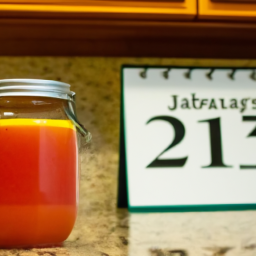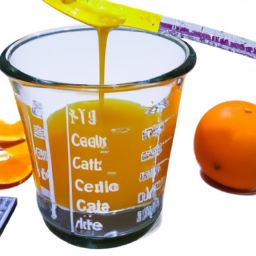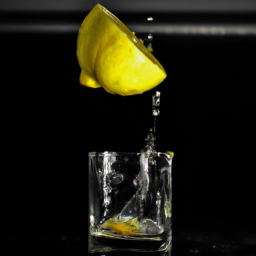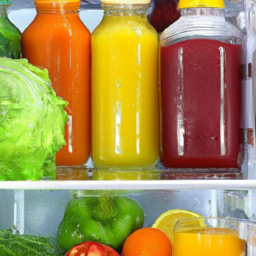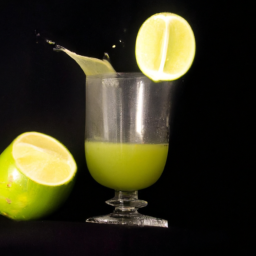As someone who enjoys making fresh juices at home, I have often wondered how long they can last and stay fresh. The shelf life of freshly made juice depends on various factors, including the type of fruits and vegetables used, the juicing method, and how it is stored.
In this article, I’ll explore the factors that affect the shelf life of homemade juice and provide tips for extending its freshness. I’ll also discuss how to tell if your juice has gone bad and what safety precautions you should take when making and storing homemade juice.
Whether you’re a seasoned juicer or just starting out, understanding the shelf life of homemade juice is crucial for ensuring that you’re getting the most out of your homemade creations.
Key Takeaways
- Proper storage is crucial for extending the shelf life of homemade juice.
- High-speed blenders and juicers introduce more oxygen, causing faster spoilage.
- Freshness indicators such as color, odor, and taste should be checked regularly.
- Homemade juice should be consumed within 3-5 days and frozen to extend the shelf life.
Factors that Affect the Shelf Life of Homemade Juice
Let’s talk about the factors that affect how long your homemade juice lasts! There are a few things that can impact the shelf life of your juice, including the ingredients you use, how you store it, and the method you use to extract the juice.
For example, certain fruits and vegetables have enzymes that can cause the juice to spoil more quickly. Additionally, if you don’t store your juice properly, it can oxidize and lose its nutritional value.
Another factor that can affect the shelf life of homemade juice is the method you use to extract the juice. For example, if you use a high-speed blender or juicer, it can introduce more oxygen into the juice, which can cause it to spoil more quickly. On the other hand, if you use a cold press juicer or a hand juicer, the juice may last longer because it’s not exposed to as much oxygen.
These factors can all impact the taste and nutritional value of your homemade juice, so it’s important to understand how they work and how to store your juice properly. Understanding expiration dates is also important, which we’ll talk about in the next section.
Understanding Expiration Dates
You need to check the expiration date on your juice to make sure you don’t drink something that’s gone bad and get sick, trust me, it’s not worth the risk. Understanding expiration dates is crucial in ensuring that you consume fresh and safe homemade juice.
Expiration dates are typically printed on the label of store-bought juices, but for homemade juice, you’ll have to label the container yourself. When checking an expiration date, you have to consider the type of juice and the storage method used. Some juices, such as citrus juices, have a shorter shelf life compared to others.
In general, the fresher the juice, the better it is for your consumption. You can also rely on other freshness indicators, such as color, odor, and taste, to determine if a juice has gone bad. However, it’s still best to follow the expiration date and store homemade juice properly to get the most out of its freshness.
To prolong the shelf life of homemade juice, you need to consider the right storage method. One simple way is to transfer the juice from a blender to an airtight container and store it in the refrigerator. Another option is to use a vacuum sealer to remove air from the container and preserve the freshness of the juice for longer.
Proper storage can extend the shelf life of the juice for up to a week or more.
How to Store Homemade Juice
To keep your freshly-made juice at its best, it’s important to store it properly. One of the best ways to do this is by placing it in an airtight container. Juice storage containers are readily available in various sizes and shapes. When choosing a container, consider the amount of juice you have and the length of time you plan to store it.
A small container is ideal for a one-day supply, while larger containers are suitable for juice that you plan to consume over several days. Aside from the container, the temperature of the refrigerator is also important. The ideal temperature for storing juice is between 34°F and 40°F. This range helps slow down the process of oxidation, which can cause the juice to spoil quickly.
Proper storage is one of the best preservation methods for homemade juice. In the next section, we’ll discuss some tips for extending the shelf life of your juice.
Now that we know the best ways to store homemade juice, let’s dive into some tips to help extend the shelf life even further.
Tips for Extending the Shelf Life of Homemade Juice
Boost the lifespan of your fresh juice by following these savvy storage strategies. The key to extending the shelf life of homemade juice is to minimize exposure to air, light, and heat. Below are some tips to help you keep your juice fresher for longer:
| Storage Method | Lifespan |
|---|---|
| Refrigerator (sealed container) | 24-48 hours |
| Freezer (airtight container) | 3-6 months |
| Vacuum Sealed | 5-7 days |
First, store your juice in a sealed container in the refrigerator. This will prevent air from getting to the juice and causing oxidation, which can make the juice taste stale and lose nutritional value. If you want to keep your juice for longer, consider freezing it in an airtight container. This method can extend the lifespan of your juice for up to 6 months. Finally, if you have a vacuum sealer, use it to seal your juice. This will remove any air from the container, preventing oxidation and increasing the lifespan of your juice to 5-7 days.
Juicing is a great way to boost your health and wellness, but what can you do with the leftover juice pulp? There are many ways to use leftover juice pulp, such as adding it to soup, smoothies, and baked goods. The pulp is rich in fiber and nutrients, making it a great addition to any recipe. However, it’s important to remember that juice is still a perishable item, and signs of spoilage can occur. In the next section, we will discuss the signs that your homemade juice has gone bad.
Signs that Your Homemade Juice Has Gone Bad
If your fresh juice starts to smell sour or has an unusual flavor, it may be a sign that it has spoiled. Other signs that your homemade juice has gone bad include a cloudy appearance, mold growth, or fizzy bubbles. When this happens, it’s crucial to discard the juice to avoid any potential health risks.
There are ways to prevent spoilage and extend the shelf life of your homemade juice. One of the most effective ways is to store the juice in an airtight container in the refrigerator or freezer. It’s also best to consume the juice within three to five days and avoid leaving it at room temperature for too long.
Keep in mind that consuming spoiled juice can lead to food poisoning, which can cause symptoms such as nausea, vomiting, and diarrhea. To ensure your safety, it’s important to take necessary precautions when handling and consuming homemade juice.
Safety Precautions
As someone who regularly makes homemade juice, it’s important to take safety precautions to avoid any potential health risks.
One key point is to always discard any moldy juice, as consuming it can lead to food poisoning.
Additionally, it’s important to avoid cross-contamination by properly cleaning all equipment and surfaces used in the juicing process.
Lastly, practicing proper hygiene, such as washing hands before handling ingredients, can also help prevent the spread of harmful bacteria.
Discarding Moldy Juice
Don’t let moldy juice ruin your day; toss it out and start fresh with a new batch. Discarding moldy juice is important to avoid contamination and prevent the growth of harmful bacteria.
Here are a few things to keep in mind when disposing of moldy juice:
-
Always discard any juice that appears moldy or has an unusual odor. It’s better to be safe than sorry, so if in doubt, throw it out.
-
Avoid pouring moldy juice down the sink or toilet as it can contaminate the water supply. Instead, dispose of it in a sealed plastic bag and place it in the trash.
-
Clean the container thoroughly before making a new batch of juice to prevent cross-contamination.
-
Store the juice in the refrigerator and consume it within 3-4 days to reduce the risk of mold growth.
To avoid cross-contamination, it’s important to take proper precautions when handling and storing homemade juice.
Avoiding Cross-Contamination
To keep your juice fresh and safe, make sure you take steps to avoid cross-contamination. This means preventing contamination from other foods, as well as cleaning equipment properly. When making juice, it’s important to wash your hands thoroughly and clean all surfaces and equipment that will come in contact with the juice. This includes cutting boards, knives, juicers, and containers.
One way to prevent cross-contamination is to use separate cutting boards and utensils for fruits and vegetables, and to designate a specific juicer for only making juice. It’s also important to properly clean all equipment after each use. This can be done by washing with hot, soapy water and allowing to air dry. Using a dishwasher is also an effective way to clean equipment, as long as it is dishwasher safe. By taking these steps, you can ensure that your homemade juice is safe and free from harmful bacteria.
| Equipment | Cleaning Method | Frequency |
|---|---|---|
| Cutting Board | Wash with hot, soapy water | After each use |
| Knife | Wash with hot, soapy water | After each use |
| Juicer | Wash with hot, soapy water or run through dishwasher | After each use |
| Container | Wash with hot, soapy water or run through dishwasher | After each use |
| Hands | Wash with hot, soapy water | Before and after handling food |
In addition to preventing contamination, proper hygiene is also important when handling food.
Proper Hygiene
Maintaining proper hygiene while handling food is crucial for ensuring the safety and health of everyone who consumes it. This is especially important when it comes to homemade juice, as the juicing equipment can easily become contaminated if not cleaned properly.
One of the first steps in maintaining proper hygiene is to wash your hands thoroughly before handling any food or equipment. This will help to prevent the spread of bacteria and other harmful microorganisms.
In addition to washing your hands, it’s also important to clean and sanitize your juicing equipment after each use. This can be done by washing the equipment with hot, soapy water and then sanitizing it with a solution of one tablespoon of bleach per gallon of water.
It’s also important to use clean cutting boards and utensils when preparing fruits and vegetables for juicing. By following these simple steps, you can help to ensure that your homemade juice is safe and healthy to consume.
As we move on to the next section about common mistakes to avoid, it’s important to keep in mind the importance of proper hygiene in juicing. By avoiding these common mistakes, you can help to prevent contamination of your juicing equipment and ensure that your homemade juice is safe and healthy to consume.
Common Mistakes to Avoid
As someone who loves making homemade juice, I’ve learned some important lessons about preservation along the way.
One common mistake is assuming that juice lasts forever in the fridge. In reality, most fresh juices only have a shelf life of three to five days.
Another question I’ve encountered is whether it’s safe to freeze homemade juice. The good news is that you can extend the life of your juice by freezing it, but there are some important guidelines to follow.
Finally, many people wonder if it’s okay to drink expired juice. The short answer is no, as expired juice can harbor harmful bacteria and toxins.
How Long Does Juice Last in the Fridge?
Hey, did you know that your homemade juice can last up to a week in the fridge? However, this is only possible if you follow proper juice storage tips and refrigeration best practices. Here are some things to keep in mind to ensure your juice stays fresh for as long as possible:
- Store your juice in an airtight container to prevent air exposure that can cause oxidation and spoilage.
- Use glass containers instead of plastic to prevent any potential chemical leaching.
- Fill the container to the top to minimize air exposure.
- Refrigerate your juice immediately after making it to slow down bacterial growth.
Ideally, you should store your juice at a temperature below 40°F to keep it fresh for a longer time.
By following these tips, you can ensure that your homemade juice stays fresh for up to a week in the fridge. However, if you need to store your juice for a longer period, you may wonder if you can freeze it. Let’s explore that in the next section.
Can You Freeze Homemade Juice?
Now that we know how long juice lasts in the fridge, let’s talk about freezing homemade juice. Freezing is a great way to extend the shelf life of your juice and prevent it from going bad. However, it’s important to use proper freezing techniques and thawing options to ensure the quality and safety of your juice.
When it comes to freezing homemade juice, there are a few things to keep in mind. First, make sure to use airtight containers or freezer bags to prevent freezer burn and contamination. Second, leave some room at the top of the container or bag to allow for expansion during freezing. Finally, label and date your containers or bags so you know how long they’ve been in the freezer.
When it’s time to thaw your frozen juice, there are a few options. You can thaw it in the fridge overnight, or you can place it in a bowl of cold water to speed up the process. Avoid thawing juice at room temperature, as this can promote bacterial growth and spoilage. Once thawed, give your juice a good shake or stir to ensure it’s well mixed before drinking.
Moving on to the next topic, let’s discuss whether it’s safe to drink expired juice.
Is It Safe to Drink Expired Juice?
You might be tempted to take a sip of that expired juice sitting in your fridge, but be warned, it could be a ticking time bomb waiting to explode. Consuming expired juice can pose serious health risks, including foodborne illness and bacterial contamination.
To ensure safe consumption, it’s important to follow proper storage techniques and freshness maintenance. Here are a few tips to keep in mind:
- Always check the expiration date on the juice container before consuming.
- If the juice has been opened, it should be consumed within 7-10 days, even if the expiration date is further out.
- Store juice in the fridge at a temperature of 40°F or below to inhibit bacterial growth.
- If the juice has an unusual odor, appearance, or taste, it’s best to discard it.
By taking these precautions, you can avoid the potential dangers of expired juice and enjoy the health benefits of a fresh and nutritious beverage.
Now, let’s dive into some popular homemade juice recipes!
Popular Homemade Juice Recipes
I’d like to share with you some of my favorite homemade juice recipes that are not only delicious but also packed with nutrients.
First up is my go-to green juice, which includes kale, spinach, cucumber, celery, and green apple.
Next, I love making a Carrot-Apple-Ginger juice, which is a great source of vitamin A and has a zesty kick from the ginger.
Lastly, Beetroot juice is a personal favorite, as it’s loaded with antioxidants and has a beautiful vibrant color.
Give these recipes a try and let me know what you think!
Green Juice
Green juice is a refreshing and healthy drink, but have you ever wondered how long it stays good for when you make it at home? Here are some things to consider:
-
Benefits of drinking green juice: Green juice is packed with nutrients like vitamins, minerals, and antioxidants that can help boost your immune system, improve digestion, and provide energy throughout the day. It can also help detoxify your body and promote healthy skin and hair.
-
Best time to drink green juice: The best time to drink green juice is in the morning on an empty stomach. This allows your body to absorb the nutrients more efficiently and can help kickstart your metabolism for the day.
-
Shelf life: Homemade green juice can stay fresh for up to 72 hours if stored properly in an airtight container in the refrigerator. However, it is best to consume it within 24-48 hours to ensure maximum freshness and nutrient content.
-
Signs of spoilage: If your green juice has a sour or fermented smell or taste, or if it appears cloudy or discolored, it may have gone bad and should be discarded.
With that in mind, let’s move on to the next section about carrot-apple-ginger juice.
Carrot-Apple-Ginger Juice
Carrot-Apple-Ginger juice is a delicious and nutritious way to start your day. This juice is packed with vitamins and minerals that provide numerous health benefits.
Carrots are rich in beta-carotene, which is converted into vitamin A in the body and helps improve vision and immune function. Apples are high in antioxidants and fiber, which can aid in digestion and lower cholesterol levels. Ginger is known for its anti-inflammatory properties, which can help reduce pain and inflammation in the body.
When making Carrot-Apple-Ginger juice, it’s important to use the best juicing equipment to ensure that you get the most out of your ingredients. A high-quality juicer will extract the maximum amount of juice from your fruits and vegetables, leaving behind minimal pulp and waste.
Juicing benefits include increased energy, improved digestion, and glowing skin. Drinking this juice regularly can also help boost your immune system and reduce inflammation in the body.
Transitioning to the subsequent section about beetroot juice, it’s important to note that this juice is also packed with nutrients and can provide numerous health benefits.
Beetroot Juice
Beetroot juice is a vibrant and flavorful way to incorporate essential nutrients into your diet. It’s packed with vitamins and minerals including folate, potassium, manganese, magnesium, and iron.
In addition, beetroot juice contains nitrates which can help improve blood flow and lower blood pressure. It’s also a good source of antioxidants which can aid in reducing inflammation and improving overall health.
The benefits of beetroot juice are numerous, and it’s important to consume it at the right time to maximize these benefits. The best time to drink beetroot juice is in the morning, on an empty stomach. This allows the nutrients to be absorbed more easily by the body.
It’s also important to note that beetroot juice can have a temporary effect on urine and stool color, but this is normal and shouldn’t be a cause for concern. Incorporating beetroot juice into your diet can be a simple way to improve your overall health and well-being.
Frequently Asked Questions
Can I freeze homemade juice to extend its shelf life?
Yes, I freeze homemade juice to extend its shelf life. Freezing juice is one of the most effective preservation techniques. It maintains the nutrients and flavor, making it a convenient option.
Is it safe to drink homemade juice that has been left out overnight?
Drinking homemade juice that has been left out overnight is not safe due to the risk of bacterial growth. This can lead to foodborne illnesses. Always refrigerate or freeze juice to maintain food safety.
How long does homemade juice made with citrus fruits last compared to other fruits?
Citrus juice shelf life varies based on preservation techniques. Homemade juice made with citrus fruits typically lasts 2-3 days in the refrigerator. Proper storage and use of preservatives can extend shelf life up to a week.
What are some ways to tell if homemade juice has gone bad?
To tell if homemade juice has spoiled, look for signs like mold, off odor, or separation. Understanding the science of shelf stability and using proper preservation techniques, such as refrigeration and pasteurization, can extend freshness.
Can I mix different types of fruits and vegetables in my homemade juice?
Experimenting with different juice combinations can provide a variety of nutritional benefits. However, it’s important to consider the flavors and textures of each fruit and vegetable to ensure a balanced and enjoyable blend.
Conclusion
In conclusion, the shelf life of homemade juice can vary depending on several factors. It’s important to understand the expiration dates of the ingredients used and to store the juice properly in order to extend its shelf life. Signs that your homemade juice has gone bad should not be ignored, as consuming spoiled juice can lead to foodborne illness.
Overall, making your own juice can be a healthy and cost-effective way to enjoy a refreshing beverage, but it’s important to take safety precautions and avoid common mistakes. By following these guidelines and experimenting with popular homemade juice recipes, you can enjoy delicious and nutritious drinks for days to come.
Remember, freshness is key when it comes to homemade juice, so don’t hesitate to experiment and create your own unique blends. As the saying goes, "Variety is the spice of life."
Ilana has been a vegan for over 10 years. She originally made the switch for health reasons, but soon found herself becoming more and more passionate about the ethical and environmental implications of a vegan lifestyle. Ilana is the author of The Graceful Kitchen, a blog all about veganism. She loves to cook up delicious and nutritious vegan meals, and share her recipes with others who are interested in leading a cruelty-free life. Ilana is also a strong advocate for using whole foods as the foundation of a healthy diet, and believes that going vegan is one of the best ways to achieve this.
